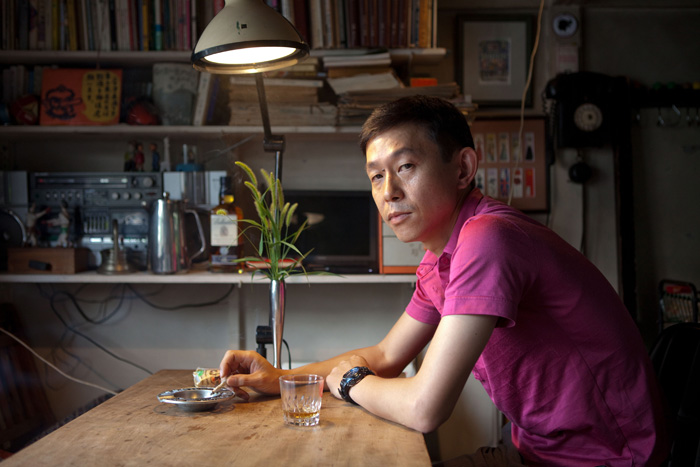星野有樹さん(映画作家、写真家)
愉しくて仕方がないほどに魅了された「映像」との出会い
父・英樹さんが写真家で広告写真の仕事をしていたことから、幼少期よりカメラは身近な存在だった星野さん。このことが写真家になることに直接的に影響があったわけではないと話すが、カメラが流行った高校時代に仲間たちと英樹さんの暗室を借りては現像したりしていた。この体験を通して、撮ったものをかたちにする喜びを知ることができたのは大きかったのではないだろうか。 大学卒業後、友人の紹介で映画監督の甲斐田祐輔さんと出会う。会ったその日にふたりは意気投合し、翌日、甲斐田さんの撮影現場にスチールカメラマンとして招かれた。映像を撮る現場に居合わせるのは初めてだったが、この日を境にすっかり「Motion Picture(映画)」の世界に魅了されていく。本格的に映画を撮りたいと考えた星野さんは、大金をはたいて16mmフィルムのカメラを買い、手探りながらも自分たちで映画を撮りはじめた。この一連の出会いと作業があまりに面白くて仕方がなかったそうで、星野さんと映像との出会いの原点はここにあると振り返る。 写真と映画を撮ることに違いはあるのだろうか? 「写真は孤独な作業で、撮影する瞬間が勝負だけど、映像は登場人物やスタッフもいる総合芸術で、撮ったあとも作業があるところが大きく違います。とりわけ物語のある映画はフィクションなので、俳優が演じ、動きがあることも写真と決定的に違うところです。動画を撮影をしているときは、電車の窓から外を覗く子どものような気持ちになります。わぁ、動いてる!あ、鳥も飛んだ!おじさんが走ってきた!とかね。予想もしないことがどんどんフレームのなかに入ってくるから止められなくなるんです。いまはデジタルカメラですから際限なく撮れるけれど、昔はフィルムだったから、当時僕が持っていたぜんまい式のカメラだと1カット20秒、100フィート用のカメラにモーターを装着しても最長で2分45秒しか撮れませんでした。だから、人物のいない実景カットでは10秒で一度止めるというルールを自分に課しましたが、結局止められなくて12〜13秒になってましたね(笑)。これは写真にも共通することだけど、たとえば景色を撮っていると、どんどん移り変わっていく様子から目が離せなくなるのです。もっといい景色が見られるかもしれないと期待が募り、同じ場所から動けなくなる。デジタルの場合その場で見られるから納得して終えられるけれど、フィルムの場合はその場で見られない分、光が変わっていくに連れて撮っておきたい衝動に駆られるんですね」 なかでも、天気がいい日の夕景に出会うと、いろいろなものがキラキラして見え、「どこに行って撮ろう」と焦って、人知れず興奮したりするそうだ。 星野さんの活動に境界がないようにも見受けられるのは、その視線が追い求めるものが、いつも変わらないからなのかもしれない。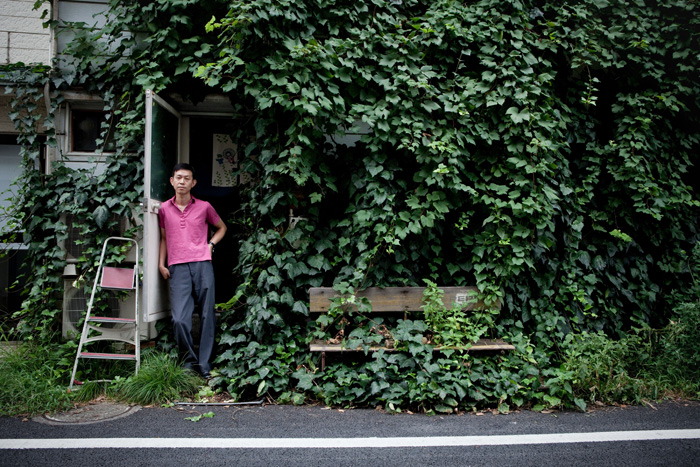
星野さんの作業場の1階にある古道具店『QUEEN’S HOTEL antiques』の裏手にて。壁を覆う蔦(つた)が見事。
独自のスタイルが確立された「映画づくり」
映画監督でも映像作家でもない「映画作家」と自らを称する星野さんは、製作、監督、脚本、撮影、キャスティング、宣伝に至るすべてを手がける。どんな脚本でもディレクションできることが映画監督だとするならば、職人として監督業に徹することができることに憧れる一方で、自分には向いていないと語る。映像作家という言葉も、映像はつくるものではなくそこに在るものだと思うので、なんだかしっくりとこないのだそうだ。 「20代から撮りはじめて、やりたいと思うことをやめなかったらこうなっていました。“やめなかった”ということが強みなのかもしれない。やりたいことがあってもやらないひとはたくさんいるし、途中でやめてしまうひともいるけれど、僕の場合は撮ることをやめなかっただけ。それはやっぱり、甲斐田君と初めて撮った映画がものすごく愉しかったからだと思います。撮影として参加した1本目の『Two Deaths Three Births』と2本目の『Raft』。3本目は脚本と撮影として参加し、俳優、西島秀俊さん主演の『すべては夜から生まれる』という作品でした。とりわけ3本目は過酷な現場で、撮影していて疲れてくると、いろいろな伝説が生まれるんですよ。でもそれがまた映画の魔力というか、だからみんな映画を撮り続けたくなるんでしょうね。いまは、撮りたければ誰でも撮れる時代になったから、みなさんにもぜひ撮ってみて欲しいなと思います」 映画を撮ることは、愉しくて仕方がないと思う反面、いやで仕方がないと思うこともあるそう。撮影現場を探して、方々に連絡して、スケジュールを合わせて、重い機材を運んで、リハーサルして…。しかし、ひとたび現場に入ってしまうと、じりじりと自分が熱くなっていくのを感じる。最もワクワクする瞬間は、星野さんが書いた脚本を俳優が生きはじめたとき。それまでは自分のなかだけにあったものが、俳優たちの芝居を通して現実のものになっていくさまを見ていると、俳優ってすごいと、心の底から感心し、尊敬するそうだ。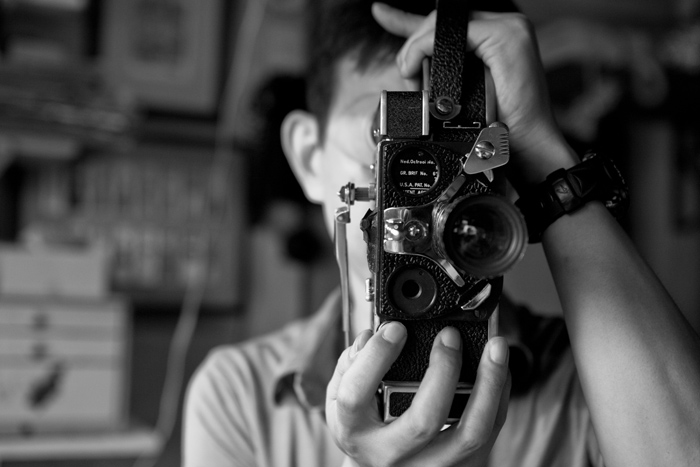 星野さんの撮影スタイルは独特だ。一般的に監督と言うと、自身が欲しい表情を俳優から引き出すものなのかもしれないが、星野さんの場合は、俳優に任せるというのが信念。本読みをして、撮影の1日前にリハーサルの日をとって、俳優たちにそのシチュエーションに慣れてもらい、その間に星野さんはカメラのアングルや照明の位置を決める。すると、俳優たちもその環境を演ずる道具として活かしながら、本番当日を迎えることができる。俳優なくしては成り立たない「映画づくり」だからこそ、俳優にとってベストな環境を用意したいし、その幅を俳優に預けることによって、星野さんはそれを逃さずに撮り収められるように最大限に準備をする。その環境を用意するためのチームワークは非常に重要で、基本的には星野さんがひとりで段取りをするが、阿吽の呼吸でアシストをしてくれる宗田君なくしては成り立たない。もちろん予算があれば、すべてをひとりでやらずに、その道のプロに喜んで頼みたいと星野さんは話す。そのぶん視点が増えるし、内容も豊かなものになると考える。しかしながら、限られた予算のなかで撮っているし、ある程度自分でできるからやっているけれど、すべてを自分でやらなくて済むのなら「判断すること」に集中できるし、監督として俳優の演技をじっくりと見ていたいそうだ。常にひとに目が向いている星野さんならではだ。
星野さんの撮影スタイルは独特だ。一般的に監督と言うと、自身が欲しい表情を俳優から引き出すものなのかもしれないが、星野さんの場合は、俳優に任せるというのが信念。本読みをして、撮影の1日前にリハーサルの日をとって、俳優たちにそのシチュエーションに慣れてもらい、その間に星野さんはカメラのアングルや照明の位置を決める。すると、俳優たちもその環境を演ずる道具として活かしながら、本番当日を迎えることができる。俳優なくしては成り立たない「映画づくり」だからこそ、俳優にとってベストな環境を用意したいし、その幅を俳優に預けることによって、星野さんはそれを逃さずに撮り収められるように最大限に準備をする。その環境を用意するためのチームワークは非常に重要で、基本的には星野さんがひとりで段取りをするが、阿吽の呼吸でアシストをしてくれる宗田君なくしては成り立たない。もちろん予算があれば、すべてをひとりでやらずに、その道のプロに喜んで頼みたいと星野さんは話す。そのぶん視点が増えるし、内容も豊かなものになると考える。しかしながら、限られた予算のなかで撮っているし、ある程度自分でできるからやっているけれど、すべてを自分でやらなくて済むのなら「判断すること」に集中できるし、監督として俳優の演技をじっくりと見ていたいそうだ。常にひとに目が向いている星野さんならではだ。
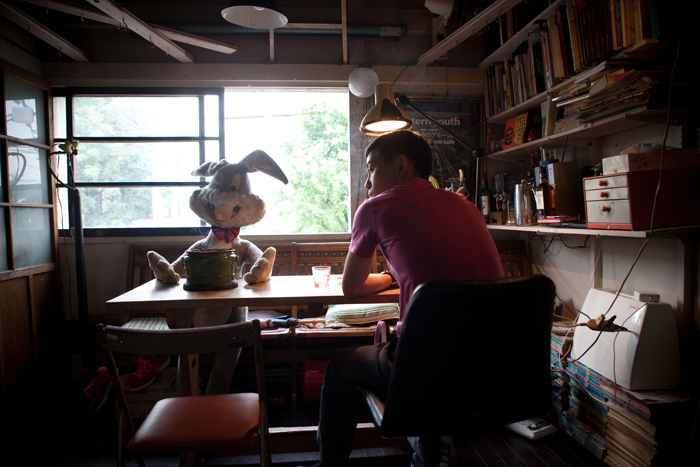
星野さんの作業場にて。
「風景」はいつも日常のなかにある
見慣れた「景色」にある視点が加わると「風景」へと生まれ変わる。そうした日常のなかに息づく「風景の誕生」を、『THREE TREE JOURNAL』の『Landscapes』では、星野さんにショートムービーとしてまとめていただいている。一面に広がる雪景色は、妻の里美(りみ)さんの実家がある長野に向かう風景で、いつもは車で通り過ぎていた景色を想い出して本作のために撮りおろした。こんなふうに、日常において星野さんがカメラを向けていると、その時その場でしか撮れないものと、ぴたりとチャネルが合う瞬間があるのだそう。 「月も芝居するんだなぁと思うこともあります。雲がぐわぁーっと現れたりね。それは特別なことではなくて、世のなかは決定的瞬間で溢れています。カメラを向けることでそれらを見つけられることは実に豊かなことだし、幸せだと思います」と語る、星野さん。眠れない夜があっても、朝になるとまた太陽がびかびかーっと光りながら登ってきて、見慣れたビルをひと息に黒い影に染める。「日常」を「非日常」に変えてしまうそんな風景の数々が、星野さんに与えるエネルギーは大きいようだ。 星野さんには『THREE』のコンセプトに共感していただき、スキンケアシリーズもご愛用いただいているが、そんな星野さんにとって「美しさ」とはどのようなものなのだろうか? 「正直に言えば、これまでに美しさとは何か?なんて考えたこともありませんでした。なぜかと言うと、美しさというのは醜さを排除してしまうもののように感じてしまうからです。でも僕自身はどちらかと言えば醜さのほうに惹かれるし、醜さのなかに美しさを見ているのかもしれません。もちろん美しいものへの憧れは大切だと思います。でも、美しくあることに抑圧されすぎてしまうと、コンプレックスにつながってしまう。たとえば美白という観点から見ると、シミやそばかすは消したいものなのかもしれないけれど、シミやそばかすは個性とも捉えられる。女性は男性よりも明らかに美しいわけだし、コンプレックスに起因する強迫観念に捉われすぎないほうがいいと思うのです。ですから、『THREE』が提唱する“自然の一部である自分を尊重し自然体で生きることこそ美しい”というコンセプトにはとても共感します」 最後に、星野さんより『THREE TREE JOURNAL』読者にメッセージをいただいた。 「映画をたくさん観てください!観たいと思う作品なら、なんでもいいのです。ひとつ僕からみなさんにおすすめの作品を挙げるなら、2000年にカンヌ国際映画祭で監督賞を受賞した『ヤンヤン 夏の想い出』。この作品を観たときに、映画ってすごいものだと思った。どこまでも行けるのだという映画の奥行きを感じました。本作を撮った台湾の映画監督で脚本家のエドワード・ヤン監督には、到底適わないと思っている映画製作者はたくさんいると思います」 『THREE TREE JOURNAL』の『Landscapes』次回の更新は10月上旬を予定。また、現在好調撮影中の『アイム・オール・ライト』の制作にしばらく勤しみ、公開に向けて進めていく。ライフワークとして撮影を続けている『最後の風景』は、生涯を通して撮り続けたいと考えている。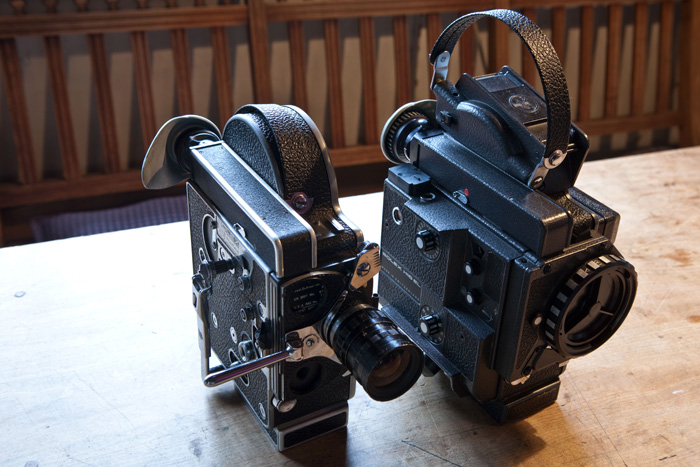
スイスの老舗カメラメーカー、BOLEX社製16mmフィルムのカメラ。映画を撮ろうと思い立ち、最初に買ったのが左の、100フィート用ぜんまい式カメラ。そのあとに買ったのが右のカメラ。マガジンを装着すると400フィートまで撮影できて、同時録音も可能。
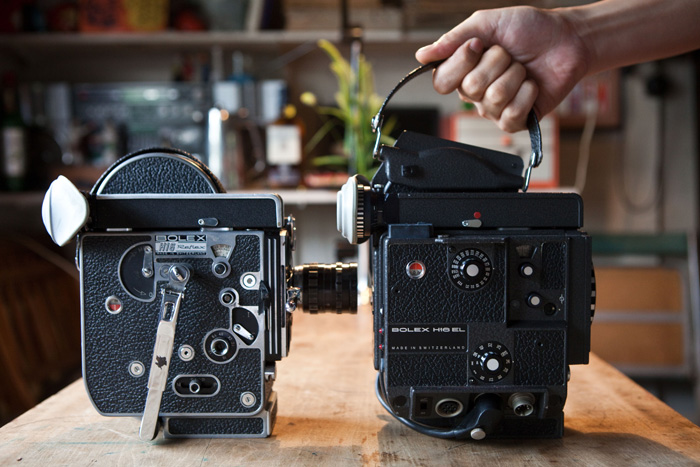
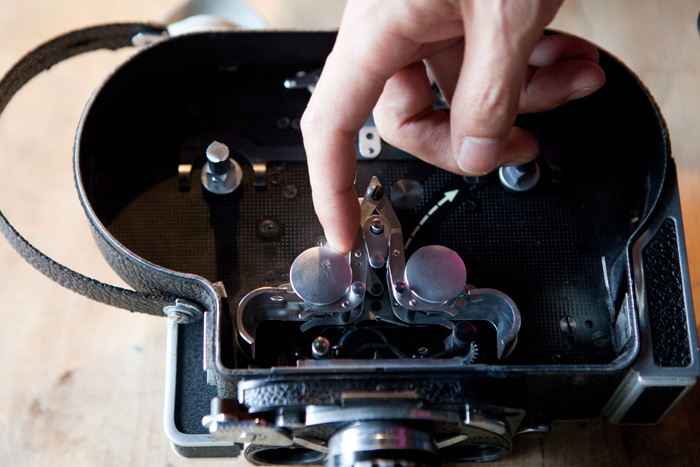
<クレジット>
PHOTOGRAPHS BY RYO ICHII
SHOOTING LOCATION AT QUEEN’S HOTEL antiques
QUEEN’S HOTEL antiques
東京都武蔵野市吉祥寺南町3-32-2
電話:0422-42-8879
営業時間:13:00-19:00 定休日:月・火・水曜日
http://blackscreen.weblogs.jp/queens/
星野有樹さんの連載コンテンツ > Landscapes
journal/landscapes/
- Guest File #06
- “I'm a filmmaker because I didn't stop filming” Yuki Hoshino (Filmmaker, Photographer)
- THURSDAY, 19th SEPTEMBER, 2013
His encounter with film that was so fun he was mesmerized
As Hoshino's father, Hideki, was a photographer who took photos for advertisements, cameras have been very familiar to him since his childhood. He claims that this did not directly influence his becoming a photographer, but rather borrowed his father's dark room with his high school friends when cameras were all the rage and developed photos. It was through this experience that he came to learn the joys of developing the photos he had taken. After graduating from college he met film director Kaida Yusuke. The two hit it off and the next day he was invited to work on Kaida's set as the still cameraman. It was Hoshino's first time on a film set. He was completely drawn in to the "Motion Picture" world. He genuinely planned to make films and purchased with great amounts of his own money 16mm film, then started filming by himself while groping around in the dark. This succession of an encounter and work was so much fun, and he recalls that his starting point was in his encounter with film. Are there any differences in filming and taking photographs? "There are big differences in that taking pictures is a solitary job and the moment you capture determines your success while filming is a collaborative art with staff and actors and the work continues after filming. Films with stories in particular are fiction, so the actors perform and there are movements so its decidedly different from photography. I feel like a child looking out the window on the train when I'm filming. Like, wow, they are moving! Oh, there goes a bird! Here comes a man running! Unexpected things enter the frame so I can't help myself. I have a digital camera so I can film limitlessly but I used to have a film camera. It was a spring-wound camera with 1 cut at 20 seconds and with a one hundred feet camera motor that when attached could film for 2 minutes and 45 seconds. I made a rule for myself to film cuts without people stopping once every ten seconds, but I often went over to 12 or 13 seconds. (Laughs) This is true for me of photography, too. For example, when I'm shooting scenery, I can't take my eyes off the changing scenery. I start to expect to see better scenery and can't change spots. With digital cameras you can check it on the spot and move on but with film you can't see it there and as the light changes you have to hurry to catch the shots you want." He says you can see things shining in the dusk scenery on sunny days, gets excited without people knowing and rushes to find where he should shoot. He can accepted that there are no borders to his work because the views he's chasing after don't always change.Movie-making where he established his unique style
Hoshino calls himself neither a movie director nor a filmmaker but rather a "movie creator". He works on everything from production, direction, filming, casting to advertising. He says that if being able to direct any screenplay is the mark of a director, he longs to be able to throw himself into directing, but feels that he's not suited for it. He thinks that the title of filmmaker doesn't sit we'll with him because he thinks that it's in that, not in movie making. "It turned out this way because I started filming in my 20s and haven't stop. "Haven't stopped" might be too strong. There are many people don't do what they want to do and others quit part way, but I just didn't give up. I think that's because the first movie I filmed with Kaida was so much fun. The first one "Two Deaths Three Births" and the second one "Raft" I participated in the filming. In the third one I participated in the screenplay and the filming was "Subete Wa Yoru Kara Umareru" starring Hidetoshi Nishijima. The 3rd one in particular was a tough shoot and when we got tired shooting lots of folk stories were born. But that's also the appeal of filmmaking, it's why everyone wants to keep filming. Anyone can film now if they want to, and I think they should." He doesn't love everything about filming movies, though. Searching for a set, contacting people, arranging schedules, carrying heavy equipment, rehearsing... However, once he's on set, he feels himself slowly heat up. His favorite moment is that in which the actors bring to life his screenplays. Seeing what had been only in him up to that point become real through their acting he is deeply moved by their skills and respects them. Hoshino's filming style is one of a kind. Generally directors bring out in the actors the emotions they themselves want but Hoshino's philosophy is to let the actors do their thing. They read the scene, have a rehearsal the day before the shoot, the actors adjust to the situation and all the while he determines the lighting and camera angles. Then they can shoot the real thing while using the actors as tools to act out the scene. The actors are indispensable for move-making, so he tries to prepare the best environment for them and he prepares it to the fullest so that he can capture it depending on the range he leaves with the actors. Teamwork is extremely important to prepare the environment and Hoshino essentially does it all by himself, but without Muneta to assist him with their mutual understanding it wouldn't be possible. Of course if there is a budget he gladly asks the pro for assistance, he says. He thinks there are more viewpoints then and the contents become more rich. They are filming on a limited budget and he does what he can by himself to a certain extent but if he doesn't have to do it all himself he can focus on what he determines and watches closely the actors' performances as a director. His eyes are suited to people all the time.The scenery is always in the everyday
When viewing the usual sights from a different viewpoint, they become scenery. In THREE TREE JOURNAL's Landscapes Hoshino collects the birth of such scenery in our daily lives in the form of short movies. The snow-covered scenery extended out all over is on the way to Nagano where his wife Rimi's childhood home is. He recalled the sights of cars always passing by and shot it for this work. In this way when he is rolling his camera, there is a moment that the things he can shoot only then and there and the channel match perfectly. "I sometimes think even the moon can act. Clouds puff out in front of us. It's nothing special. The world is full of these deciding moments. There are actually many moments you can find by rolling the camera and I think that's wonderful," he says. Even on nights when you can't sleep, the sun rises up the next morning shining brightly and the building you normally see is dyed in a dark shadow. The many sceneries he changes from everyday to not-so-everyday gives him great energy. Hoshino identifies with THREE's concept and uses our skin care series. What is beauty to him? "I honestly hadn't thought about what beauty is to me because I feel that beauty expels ugliness. However, I am attracted to ugliness and find beauty in it. Of course I also cherish longing for beautiful things. But being too repressed by being beautiful leads to having a complex. For example, from the view of whitening, wrinkles and freckles are things we try to erase. However they can also be taken as individuality. Women are obviously more beauty conscious than men so I think it's good to not bound them to an obsessive idea that contributes to complexes. That's why I strongly identify with THREE's concept of respecting oneself as a part of nature and being beautiful because you are living naturally." Lastly, we received a message for THREE TREE JOURNAL from Hoshino. "Watch lots of movies! Watch whatever you want. If I am to suggest a work to you, I'd choose "Yan Yan Natsu No Omoide" that won the award for best direction at the Cannes Film Festival in 2000. I thought movies were amazing when I saw this. I felt how deeply movies can go. I think that there are many film makers who feel themselves unacceptable to the director and screenwriter of the movie shot in Taiwan, Edward Yang." The next installment of THREE TREE JOURNAL's Landscapes will be in early October. He is working to release to the public the up-and-coming "Aimu Ooru Raito" that he has been working on for a while. He plans to spend his life shooting the "last scene" as his life work.<Captions>
(The 1st photo)
No caption
(The 2nd photo)
In the back of Hoshino's studio on the first floor of the used tool shop "QUEEN'S HOTEL antiques". The ivy covering the walls is splendid.
(The 3rd photo)
No caption
(The 4th photo)
At Hoshino's studio.
(The 5th photo)
Swiss camera maker BOLEX's 16mm film camera. The first one he bought after planning to make films is the spring-wound 100 feet camera on the left. The camera he bought afterwards on the right. With a magazine on it it could film up to 400 feet and record sound simultaneously.
(The 6th photo)
No caption
(The 7th photo)
No caption
<Credits>
PHOTOGRAPHS BY RYO ICHII
SHOOTING LOCATION AT QUEEN’S HOTEL antiques
QUEEN’S HOTEL antiques
3-32-2 Kichijoji Minami-cho Musashino-shi Tokyo
Tel: 0422-42-8879
Business Hours: 13:00-19:00, Closed: Monday, Tuesday, Wednesday
http://blackscreen.weblogs.jp/queens/
Yuki Hoshino's serial contents > Landscapes
journal/landscapes/





